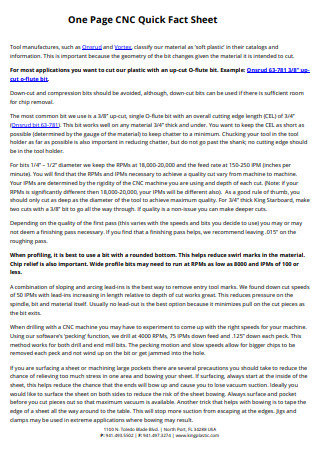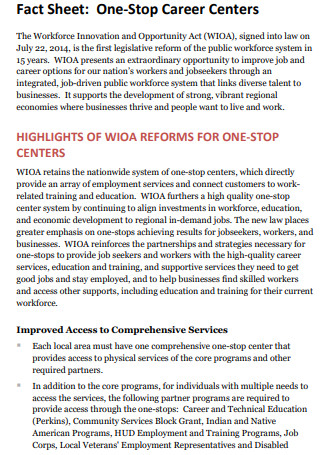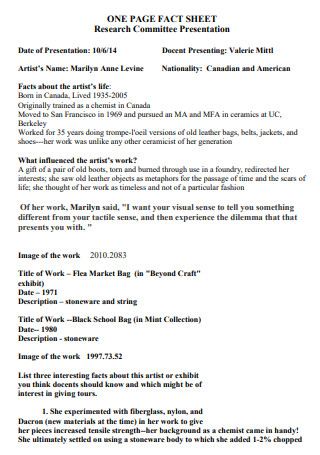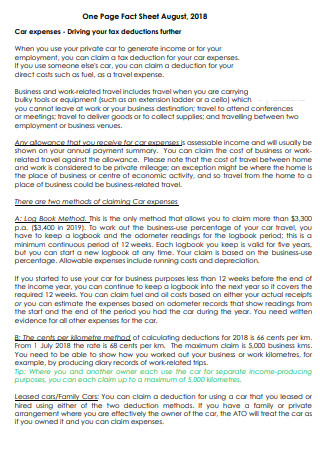5+ SAMPLE One Page Fact Sheet
FREE One Page Fact Sheet s to Download
5+ SAMPLE One Page Fact Sheet
What Is a One Page Fact Sheet?
Resources to Help Create One Page Fact Sheets
How to Make a One Page Fact Sheet
Other Components to Include in a Fact Sheet
Benefits of a Fact Sheet
The Most Common Errors in Writing
FAQs
Can fact sheets be considered credible?
How do you format a one page fact sheet?
What are other informative documents?
What Is a One Page Fact Sheet?
A Fact Sheet is a one-page document that condenses the most important facts on a topic into the smallest amount of space possible. The purpose is to present facts and significant points about a subject in a clear, succinct, and understandable manner. Students and company employees must pick what is most essential, arrange it, and convey it in their own words while creating a one page information sheet. All three of these activities have something to do with how people learn and are associated to better knowledge retention. You can check out the provided one page fact sheet example we have attached in this article.
Resources to Help Create One Page Fact Sheets
Making fact sheets necessitates extensive study and sourcing in order to obtain the most accurate and relevant information for your presentation. Depending on the emphasis of your fact sheet, you may require several types of Information. You will find research and sourcing a lot easier if you know what to look for, and you will be able to sort through the data and eliminate any information you don’t need. The following details is curated to aid you as you write your fact sheet.
How to Make a One Page Fact Sheet
Creating a One Page information sheet will be difficult if you do it without the guide found below or if you do not use any references such as the available templates. This is why making use of the information provided in this article will be beneficial to you as you write your one page fact sheet. You are not required to use a template as you follow the guide in making your one page fact sheet, but it is recommendable in order to spend less time thinking over the format and proceed to the important part of the content.
Step 1: Come up with a header
The header serves as the page’s title and offers the fact sheet a broad direction. In this part, you may also provide dates, Contact information and if possible, your company’s logo. Remember that by distributing your fact sheets as responsive links, you can update anybody who has the link, anywhere in the globe, by changing the header, turning it on or off, and refreshing the date. It is important to start off with this step because those who would be reading your one page fact sheet will be aware of your company or the source of the producer of the said document.
Step 2: Summarize your vision and mission
Use a basic bolded corporate slogan in bigger type or provide a quick but precise statement of your organization’s rationale. Explain the foundational concepts and long-term goals of your company. You may also use tags or graphs to provide visual indications of your company’s values to your one page fact sheet. In the same manner, if you are a student, then state in this section the purpose of why you are writing the fact sheet in the first place.
Step 3: Add necessary information
Provide a brief description of your company in this section. Include crucial information like your company’s size, date of establishment, kind, industry, and location, as well as a few keywords that characterize your business help people remember your company. Please feel free to include any additional information about your product, service, or company that is relevant to the main goal of the one page fact sheet. To highlight critical corporate information and streamline planning, development, and execution throughout your firm, fill out the template of your choice.
Step 4: Modify your footer
In the concluding portion of your fact sheet, provide your contact information, website, and pertinent social media connections. It is important to include details regarding where you can be found. Similar to a Property Fact Sheet, interested or potential clients would want to reach out to you. Additionally, further information can help persuade them to choose your company for your specific service.
Step 5: Add a call to action
Include a clear call to action that is relevant to the information sheet’s aim. Insert an email form module if you want to pique the interest of clients, customers, or even investors. Include a phone number or an email address to respond to if you are utilizing the information sheet for sales reasons.
Other Components to Include in a Fact Sheet
The above guide is merely the basic structure of a one page fact sheet. But if you have more available space and are confused about what information to fill it in, then this additional list is for you. This article has curated other possible components that you can include in your one page fact sheet. Again, you don’t have to include all of them but only those you see fit.
Benefits of a Fact Sheet
Still not convinced to make use of a one page fact sheet? Then this list will help persuade you of the advantages of making use of a fact sheet. Keep reading and take note of the uses and benefits there are to a fact sheet.
The Most Common Errors in Writing
When tackling a piece of writing, most editors go for the broad picture to conduct major edits. You are looking at the story’s content and how it flows, whether everything makes sense, if the tone is suitable, and if there are any concerns that readers could have that you didn’t address. This is what is often given the term defensive editing, similar to defensive driving. After that, you may move on to minor editing for the finer points of mechanics and language.
FAQs
Can fact sheets be considered credible?
According to Taylor of the University of Dayton, the facts are what determine credibility. Fact sheets are meant to educate individuals about topics they may not be familiar with. Facts are gathered through various means, some methods are through an extensive study and conducted interviews. Public relations professionals will seek government and scientific data outside of the organization. Public relations professionals will also seek the organization’s rivals and credible commercial research sources for information. Facts are proof that will persuade the audience to believe what your company’s point of view is.
How do you format a one page fact sheet?
A 10-14 point font is recommended for one page safety data sheet. The page should begin with the type of document which in this case, is a fact sheet. Followed by a very brief header that summarizes the page’s content. When possible, utilize bullets, allow a lot of white space, and underline key ideas with bolding, text boxes, and visuals. Simple graphs and charts may also provide information to the reader with just a look, and pie charts are the easiest to comprehend. Finally, include references for further information and in electronic communications, including links.
What are other informative documents?
- Brochures
- Pamphlets
- Flyers
- Broadsheet
- Leaflet
- Booklet
Now that you are aware of what a one page data sheet is and how to make your own, you are more than ready to start writing one for yourself or for the benefit of your company. Make sure to keep in mind the additional information listed in this article as it will also help you when you write your fact sheet. Go on over and review the available one page data sheet template so you can choose which suits your preferences more.






